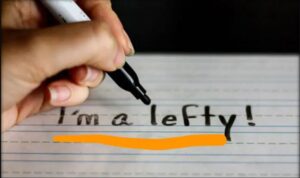Left-handers and the society
Left-handers and their everyday problems
Arguably 2 to 30 percent of any human population is left-handed or ambidextrous, with most estimates hovering around 10%, depending upon the criteria used to assess handedness (Holder 1992).
Left-handers and ambidextrals routinely encounter difficulties in their daily lives that most right-handers do not fully appreciate. Most of these difficulties are trivial, annoying, and frustrating. But some problems encountered by left-handers and ambidextrals are serious, resulting in lifelong problems and/or physical injury. Many of the more serious problems may be avoided or overcome with a little basic understanding and a few simple coping strategies.
Parents want what is best for their children, teachers strive to maximize individuals’ potential to learn, employers strive to maximize their profit, and manufacturers want their products to sell. The hope is for parents, educators, employers, and manufacturers to understand that the best way to achieve their goals is by listening to left-handers and ambidextrals. A quick way to describe basic obstacles left-handers and ambidextrals must overcome is to think of these as (1) intrinsic biases (pertaining to physical attributes) and (2) social-cultural biases (emotional, intellectual, and religious prejudices).
Intrinsic bias means that a tool or a system has an inherent or built-in advantage for one hand (the right) over the other (the left). “Tools” are broadly defined as utensils, musical instruments, sports equipment, etc. The majority of tools in any technological society are designed for the right-handed (Hardyck & Petrinovich 1977).
The following common tools all require left-to-right wrist turning movements more comfortable for right-handers: corkscrew, rotary dial phone, analogue clock-setting & winding, screws, lightbulbs, etc. The following are specifically designed to be used in a right-handed fashion: scissors, can openers, coffee makers, computer keyboards (numeric keypad on right), calculators and pushbutton phones (left-to-right array), golf clubs, many musical instruments (especially stringed), cars built in right-lane countries, most hand-held power tools (drills, saws), etc. Many of these tools are also used in the work environment (telephones, computers, power tools, kitchen utensils). But the real danger is often encountered in manufacturing and construction environments: industrial meat slicers, drill presses, band saws, textile machinery, production lines, and heavy equipment. Some researchers believe the risk to left-handers under such conditions can be significantly greater than to their right-handed co-workers (Coren 1992).
Presented with ubiquitous right bias in the physical world, a left-hander or ambidextral has two options: (1) to learn to use the tool in a right-handed fashion (awkward and inefficient at best), or (2) to learn to somehow hold the tool backwards so that it can be manipulated with the left hand (often dangerous). This is one reason that left-handers, in general, are more flexible in their hand usage than right-handers (Bryden 1982) (e.g. how many right-handers hold a circular saw backwards or in the left hand, or open a wine bottle holding the corkscrew in the left hand?)
Social and cultural biases are emotional or intellectual beliefs and/or prejudices, including religious beliefs and conventions (Payne 1987) and social mores (Dawson 1977). (For instance, small children have been accused of being in cahoots with the devil, with Satan, or of being a communist simply for trying to use their left hand!) The two tasks under the most cultural influence are probably the use of a writing instrument and eating utensils (Teng et al. 1979; Thompson & Marsh 1976; Holder 1992). This means that left-handers are often literally “forced” by society to use the right hand for these tasks.
Famous left-handers
The terms «famous» and «left-hander» are both subjective judgments. For this page, «famous» means that someone steeped in American culture will recognize most of these names, and «left-handed» is a loose common classification meaning to write with and/or use the left hand for manual tasks. A few of the people listed here might be better described as «ambidexterous».
Left-Handed U.S. Presidents
James A. Garfield, 20th
Herbert Hoover, 31st
Harry S. Truman, 33rd
Gerald Ford, 38thRonald Reagan, 40th
George H.W. Bush, 41st
Bill Clinton, 42nd
Barack Obama, 44th
Left-Handed Politics
McGeorge Bundy, presidential advisor
Benjamin Franklin, statesman/publisher/scientist
Jean-Marc Froidevaux, Swiss politician
Ruth Bader Ginsberg, Supreme Court Justice
Senator Daniel Inouye
Anthony Kennedy, Supreme Court Justice
Alan Keyes, US Senator, US Ambasador
Brigadier Gen. Lee Hsien Loon, Deputy Prime Minister of Singapore
John McCain, US Senator
Robert S. McNamara, Secretary of Defense
William Perry, Secretary of DefenseNelson Rockefeller, Vice President
Miscellaneous Left-Handers
Joan of Arc, French heroine
Lloque Yapanqui, Inca monarch
Ramses II, Egyptian pharaoh
Tiberius, Roman emperor
Alexander the Great
Charlemagne, Holy Roman emperor
Julius Caesar, Roman general
Napoléon Bonaparte, French emperor
Josephine de Beauharnais
King Louis XVI of France
Queen Victoria of
King George II of
King George VI of
Prince Charles of
Prince William of
Fidel Castro, Cuban leader
Benjamin Netanyahu, Israeli prime-minister
Left-Handed Authors
James Baldwin, novelist
Bet Bowen, horror novelist
Peter Benchley, novelist
Lewis Carroll
Richard Condon, novelist
Jean Genet
Marshall McLuhan
Diane Paul
Left-Handed Musicians
Carl Philipp Emanuel Bach, composer
David Byrne (Talking Heads)
Glen Campbell
Vicki Carr
Natale Cole
Kurt Cobain (Nirvana)
Phil Collins (Genesis)
Billy Corgan (Smashing Pumpkins)
Dick Dale (guitarist)
Don Everly (The Everly Brothers)
Phil Everly (The Everly Brothers)
Bela Fleck, jazz musician
Errol Garner, jazz pianist
Judy Garland
Crystal Gayle
Kevin Griffin, guitarist & lead singer (Better than Ezra)
Thomas Hedley, vocalist/musician
Jimi Hendrix
Isaac Hayes
Tony Iommi, guitarist (Black Sabbath)
Left-Handed Artists
Albrecht Dürer
M.C. Escher
Hans Holbein
Paul Klee
Michelangelo
LeRoy Neiman
Raphael
Leonardo da Vinci

